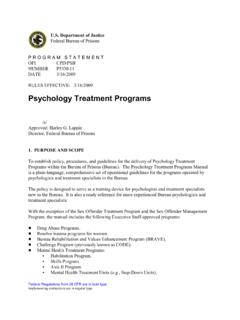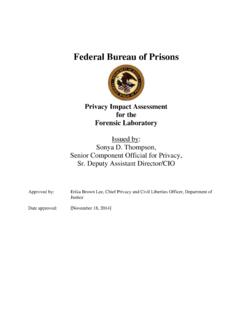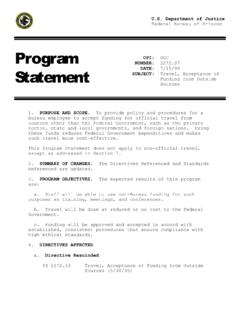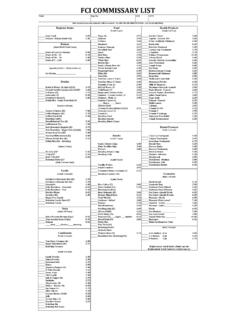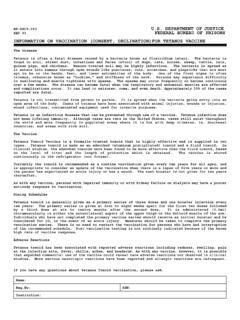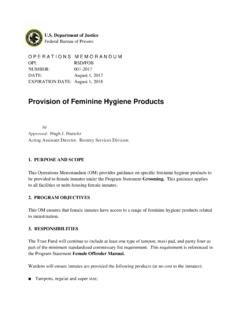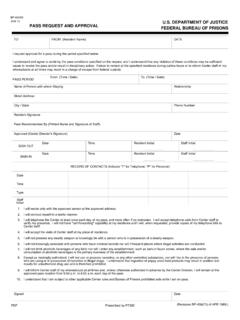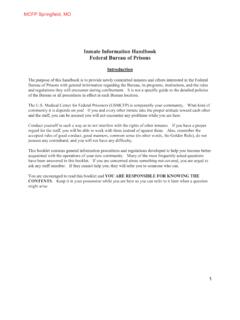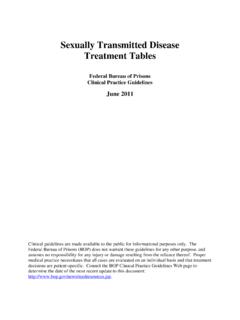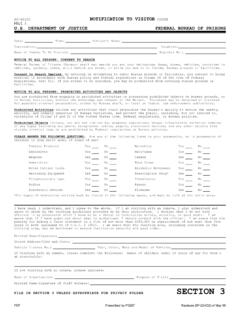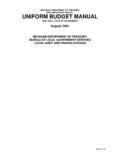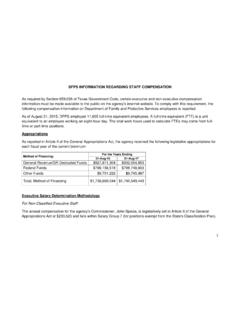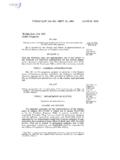Transcription of Incoming Publications - Federal Bureau of Prisons
1 Department of Justice Federal Bureau of Prisons P R O G R A M S T A T E M E N T OPI CPD/CPB NUMBER DATE November 9, 2011 Incoming Publications /s/ Approved: Thomas R. Kane Acting Director, Federal Bureau of Prisons 1. PURPOSE AND SCOPE Purpose and scope. Except when precluded by statute (see ), the Bureau of Prisons permits an inmate to subscribe to or to receive Publications without prior approval and has established procedures to determine if an Incoming publication is detrimental to the security, discipline, or good order of the institution or if it might facilitate criminal activity. The term publication , as used in this subpart, means a book, booklet, pamphlet, or similar document, or a single issue of a magazine, periodical, newsletter, newspaper, plus such other materials addressed to a specific inmate such as advertising brochures, flyers, and catalogs. Section 7 of this Program Statement contains procedures to implement Sec.
2 615 of The Commerce, Justice, State Appropriations Act of 2000 ( 106-113) (hereafter referred to as the Ensign Amendment). a. Summary of Changes Policy Rescinded PS Incoming Publications (1/10/03) This revision updates references to the Ensign Amendment. Federal Regulations from 28 CFR are in bold type. Implementing instructions are in regular type. 11/9/2011 Federal Regulations from 28 CFR: this type. Implementing instructions: this type. 2 b. Program Objectives. Expected results of this program are: Inmates will be permitted to receive and retain Publications that do not threaten the security, good order, or discipline of the institution, or that may facilitate criminal activity, or are otherwise prohibited by law. Publications determined detrimental to the security, good order, or discipline of the institution or that may facilitate criminal activity, or are otherwise prohibited by law, will be excluded from Bureau facilities.
3 A safer environment for staff and inmates will be provided by strengthening procedures to prevent the introduction of contraband. c. MCC/MDC/FDC/FTC Application. Procedures in this Program Statement apply to Metropolitan Correctional Centers, Metropolitan Detention Centers, Federal Detention Centers, and Federal Transportation Centers, all of which are referred to as administrative institutions for the purposes of this Program Statement. 2. PROCEDURES Procedures. (a)(1) At all Bureau institutions, an inmate may receive hardcover Publications and newspapers only from the publisher, from a book club, or from a bookstore. The senders address must be clearly identified on the outside of the package. (2) At medium security, high security, and administrative institutions, an inmate may receive softcover Publications (for example, paperback books, newspaper clippings, magazines, and other similar items) only from the publisher, from a book club, or from a bookstore.
4 (3) At minimum security and low security institutions, an inmate may receive softcover Publications (other than newspapers) from any source. (4) The Unit Manager may make an exception to the provisions of paragraphs (a)(1) and (2) of this section if the publication is no longer available from the publisher, book club, or bookstore. The Unit Manager shall require that the inmate provide written documentation that the publication is no longer available from these sources. The approval of any request for an exception is to be documented, in writing, on an Authorization to Receive a Package which will be used to secure the item. (b) The Warden may reject a publication only if it is determined detrimental to the security, good order, or discipline of the institution or if it might facilitate criminal activity. The Warden may not reject a publication solely because its content is 11/9/2011 Federal Regulations from 28 CFR: this type.
5 Implementing instructions: this type. 3 religious, philosophical, political, social or sexual, or because its content is unpopular or repugnant. Publications which may be rejected by a Warden include but are not limited to Publications which meet one of the following criteria: (1) It depicts or describes procedures for the construction or use of weapons, ammunition, bombs or incendiary devices; (2) It depicts, encourages, or describes methods of escape from correctional facilities, or contains blueprints, drawings or similar descriptions of Bureau of Prisons institutions; (3) It depicts or describes procedures for the brewing of alcoholic beverages, or the manufacture of drugs; (4) It is written in code; (5) It depicts, describes or encourages activities which may lead to the use of physical violence or group disruption; (6) It encourages or instructs in the commission of criminal activity.
6 (7) It is sexually explicit material which by its nature or content poses a threat to the security, good order, or discipline of the institution, or facilitates criminal activity. Only the Warden may reject an Incoming publication . In the Wardens absence, only the Acting Warden may perform this function. Section 3 of this Program Statement contains procedures for returning a publication under the Ensign Amendment. In Section 3, sexually explicit and nudity are defined in terms of pictorial depictions only. Publications not subject to return under Section 3 (for example, material that does not meet a definition in that section) may still be rejected under this section. To help staff determine which materials may pose the type of threat that warrants exclusion, the following guidelines are provided. A Warden may determine that sexually explicit material of the following types will be excluded, as potentially detrimental to the security and good order or discipline of the institution, or as facilitating criminal activity: Sadomasochistic.
7 Bestiality. Involving children. In addition: 11/9/2011 Federal Regulations from 28 CFR: this type. Implementing instructions: this type. 4 The Warden must prohibit a sexually explicit publication if it is determined to pose a threat to the institution or is contrary to law. Child pornography materials, which are prohibited by law, are examples. Sexually explicit material does not include material of a news or information type. Publications concerning research or opinions on sexual, health, or reproductive issues, or covering the activities of gay rights organizations or gay religious groups, for example, should be admitted unless they are otherwise a threat to legitimate institution interests. Literary Publications should not be excluded, solely because of homosexual themes or references, if they are not sexually explicit in a manner that threatens legitimate institution interests.
8 Sexually explicit material may be admitted if it has scholarly value, or general social or literary value. (c) The Warden may not establish an excluded list of Publications . This means the Warden shall review the individual publication prior to the rejection of that publication . Rejection of several issues of a subscription publication is not sufficient reason to reject the subscription publication in its entirety. (d) Where a publication is found unacceptable, the Warden shall promptly advise the inmate in writing of the decision and the reasons for it. The notice must contain reference to the specific article(s) or material(s) considered objectionable. The Warden shall permit the inmate an opportunity to review this material for purposes of filing an appeal under the Administrative Remedy Program unless such review may provide the inmate with information of a nature which is deemed to pose a threat or detriment to the security, good order or discipline of the institution or to encourage or instruct in criminal activity.
9 In questionable cases, institution staff should consult legal staff. (e) The Warden shall provide the publisher or sender of an unacceptable publication a copy of the rejection letter. The Warden shall advise the publisher or sender that he may obtain an independent review of the rejection by writing to the Regional Director within 20 days of receipt of the rejection letter. The Warden shall return the rejected publication to the publisher or sender of the material unless the inmate indicates an intent to file an appeal under the Administrative Remedy Program, in which case the Warden shall retain the rejected material at the institution for review. In case of appeal, if the rejection is sustained, the rejected publication shall be returned when appeal or legal use is completed. See BP-A0953, Notification to Inmate and Publisher/Sender of Rejected publication , for a sample. The Warden will retain the rejected publication for 20 days from the date the inmate is sent written notification of the rejection.
10 The 20-day period allows the inmate to file an appeal under the 11/9/2011 Federal Regulations from 28 CFR: this type. Implementing instructions: this type. 5 Administrative Remedy Program. If he/she does not file within 20 days, the rejected publication may be returned to the publisher. If the inmate does file an appeal, the Warden will retain the rejected publication at the institution. The rejected publication (or the offensive portion of it) must be reviewed before a staff response is prepared for the BP-229, Request for Administrative Remedy or, when applicable, a BP-230, Regional Appeal of Administrative Remedy or BP-231, Central Office Appeal of Administrative Remedy, respectively. The Regional Office and Central Office should not respond to a BP-230 or BP-231 appeal without first reviewing either the rejected publication or a copy of the offensive portion of it. (f) The Warden may set limits locally (for fire, sanitation, or housekeeping reasons) on the number or volume of Publications an inmate may receive or retain in his quarters.
